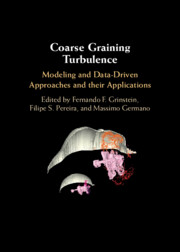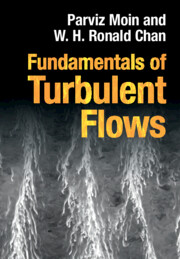Refine search
Actions for selected content:
5487 results in Thermal-fluids engineering
13 - Coarse Graining for Thermal Flows
- from Part II - Challenges
-
-
- Book:
- Coarse Graining Turbulence
- Published online:
- 31 January 2025
- Print publication:
- 06 February 2025, pp 381-418
-
- Chapter
- Export citation
4 - Filtered Density Function
- from Part I - Paradigms and Tools
-
-
- Book:
- Coarse Graining Turbulence
- Published online:
- 31 January 2025
- Print publication:
- 06 February 2025, pp 127-150
-
- Chapter
- Export citation
11 - Scale-by-Scale Nonequilibrium in Turbulent Flows
- from Part II - Challenges
-
-
- Book:
- Coarse Graining Turbulence
- Published online:
- 31 January 2025
- Print publication:
- 06 February 2025, pp 333-354
-
- Chapter
- Export citation
Contributors
-
- Book:
- Coarse Graining Turbulence
- Published online:
- 31 January 2025
- Print publication:
- 06 February 2025, pp xii-xiv
-
- Chapter
- Export citation
Frontmatter
-
- Book:
- Coarse Graining Turbulence
- Published online:
- 31 January 2025
- Print publication:
- 06 February 2025, pp i-iv
-
- Chapter
- Export citation
12 - Coarse-Graining in Multiphase Flows: From Micro to Meso to Macroscale for Euler–Lagrange and Euler–Euler Simulations
- from Part II - Challenges
-
-
- Book:
- Coarse Graining Turbulence
- Published online:
- 31 January 2025
- Print publication:
- 06 February 2025, pp 355-380
-
- Chapter
- Export citation
2 - An Overview of Scale-Resolving Simulation Models for Practical Flows
- from Part I - Paradigms and Tools
-
-
- Book:
- Coarse Graining Turbulence
- Published online:
- 31 January 2025
- Print publication:
- 06 February 2025, pp 48-90
-
- Chapter
- Export citation
16 - Transition and Multiphysics in Inertial Confinement Fusion Capsules
- from Part II - Challenges
-
-
- Book:
- Coarse Graining Turbulence
- Published online:
- 31 January 2025
- Print publication:
- 06 February 2025, pp 494-524
-
- Chapter
- Export citation
3 - Filtering Approaches and Coarse Graining
- from Part I - Paradigms and Tools
-
-
- Book:
- Coarse Graining Turbulence
- Published online:
- 31 January 2025
- Print publication:
- 06 February 2025, pp 91-126
-
- Chapter
- Export citation
1 - Numerical Simulations and Coarse-Graining
- from Part I - Paradigms and Tools
-
-
- Book:
- Coarse Graining Turbulence
- Published online:
- 31 January 2025
- Print publication:
- 06 February 2025, pp 5-47
-
- Chapter
- Export citation
Abbreviations
-
- Book:
- Coarse Graining Turbulence
- Published online:
- 31 January 2025
- Print publication:
- 06 February 2025, pp 559-563
-
- Chapter
- Export citation
Index
-
- Book:
- Coarse Graining Turbulence
- Published online:
- 31 January 2025
- Print publication:
- 06 February 2025, pp 564-566
-
- Chapter
- Export citation
6 - Coarse-Graining Turbulence Using the Mori–Zwanzig Formalism
- from Part I - Paradigms and Tools
-
-
- Book:
- Coarse Graining Turbulence
- Published online:
- 31 January 2025
- Print publication:
- 06 February 2025, pp 177-201
-
- Chapter
- Export citation

Coarse Graining Turbulence
- Modeling and Data-Driven Approaches and their Applications
-
- Published online:
- 31 January 2025
- Print publication:
- 06 February 2025

Fundamentals of Turbulent Flows
-
- Published online:
- 09 January 2025
- Print publication:
- 12 December 2024
-
- Textbook
- Export citation
3 - Energetics
-
- Book:
- Fundamentals of Turbulent Flows
- Published online:
- 09 January 2025
- Print publication:
- 12 December 2024, pp 86-108
-
- Chapter
- Export citation
5 - The Scales of Turbulent Motion
-
- Book:
- Fundamentals of Turbulent Flows
- Published online:
- 09 January 2025
- Print publication:
- 12 December 2024, pp 140-171
-
- Chapter
- Export citation
9 - Numerical Considerations for High-Fidelity Turbulence Simulations
-
- Book:
- Fundamentals of Turbulent Flows
- Published online:
- 09 January 2025
- Print publication:
- 12 December 2024, pp 254-270
-
- Chapter
- Export citation
Reviews
-
- Book:
- Fundamentals of Turbulent Flows
- Published online:
- 09 January 2025
- Print publication:
- 12 December 2024, pp ii-ii
-
- Chapter
- Export citation
Contents
-
- Book:
- Fundamentals of Turbulent Flows
- Published online:
- 09 January 2025
- Print publication:
- 12 December 2024, pp vii-x
-
- Chapter
- Export citation
